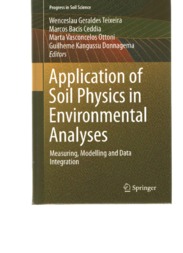Spatial Relationships Between Soil Water Content and Hydraulic Conductivity in a Highly Structured Clay Soils.
Spatial Relationships Between Soil Water Content and Hydraulic Conductivity in a Highly Structured Clay Soils.
Author(s): VIEIRA, S. R.; GREGO, C. R.; TOPP, G. C.; REYNOLDS, W. D.
Summary: The water, element essential for life, is present as a large reservoir in the soil. Soil water content varies in space as a consequence of the variability of other related properties and its study is necessary to know how this variation occurs in space and time. The objective of this study was to assess the spatial and temporal variability of soil water content and its relationships with hydraulic conductivity. Soil water content was measured with a TDR equipment and the hydraulic conductivity was measured with a constant head well permeameter at 15 and 50 em depth, in a nearly flat 1.2 ha field at the Central Experimental Farm of the Agriculture Canada, Ottawa. The soil is classified as a Rideau soil series, is primarily clay to silty clay texture. Sampling was made on a 10 m spacing square grid with 164 sampling points. Soil water content was measured on 33 dates during the frost free months in 1987, 1988 and 1989. The rate of change in soil water content was calculated for the periods which did not have any rain. The spatial variability was analyzed examining the descriptive statistical parameters, the parameters of the models fitted to individual semivariograms as a function of time and the maps obtained by kriging interpolation. It was concluded that soil structure played a very important role on the spatial distribution of hydraulic conductivity and water content. Temporal stability of water in the soil is quite different during the year probably because of the hydraulic conductivity role. Parabolic trend removal
Publication year: 2014
Types of publication: Book sections
Unit: Embrapa Territorial
Keywords: Geostatistics, Semivariogram, TDR temporal stability
Observation
Some of Embrapa's publications are published as ePub files. To read them, use or download one of the following free software options to your computer or mobile device. Android: Google Play Books; IOS: iBooks; Windows and Linux: Calibre.
Access other publications
Access the Agricultural Research Database (BDPA) to consult Embrapa's full library collection and records.
Visit Embrapa Bookstore to purchase books and other publications sold by Embrapa.

